|
 |
|
The original factory
was built on part of the old Horseley Estate,
on an area known as ‘Finch’s Devisees’ which
contained a windmill, a blade mill (known as
Partridges Mill and later, Finches Mill),
and a pool. In 1792 the estate was purchased
for £10,000 by bankers Edward Dixon and
Joseph Amphlett, who were partners in their
banking business at Dudley, and
William Bedford from Birmingham, a
solicitor. They purchased the estate to mine
some of the plentiful coal.
Joseph Amphlett became
Chief Manager and Director with a salary of
£200 per year and an allowance of £600 to
spend on his home, Horseley House. Between
1780 and 1796 he had an ironmonger’s
business in High Street, Dudley. He
died on 14th January, 1801 and his one third
share of the Horseley partnership was
inherited by his son and daughter. Edward
Dixon became High Sheriff of Worcestershire
in 1799. He died on 10th August, 1807 at the
age of 66. William Bedford was a solicitor
to the BCN (Birmingham Canal Navigations company).
He died in 1832.
The BCN built a branch
from the canal to the company’s mines with
three locks. Because of the large amount of
mining in the area, the locks soon began to
suffer from subsidence and so the canal was
rebuilt and extended to overcome the
problem. Two Newcomen pumping engines were
built to pump water out of the mines. It was
used to fill the locks. By 1813 the firm had
two blast furnaces in operation, with two Boulton and Watt blowing engines for the
blast, as well as a puddling furnace, a finery, three
cupolas and six mines. The business became
the Horsley Coal and Iron Company (with an
unusual spelling of Horseley).
Between 1815 and 1816
an engineering works was built alongside the
ironworks, beside the canal. The partners in
the venture were Joseph Smith, a local man,
and his managing partner, Aaron Manby, who
had been a banker on the Isle of Wight
before becoming an ironmaster at
Wolverhampton. In 1813 he took out a patent
for making bricks from furnace slag and
began development of a retort for the
production of coal gas. He was
a member of the Institution of Civil
Engineers.
The Horseley furnaces
remained in use until 1842 when only one was
in operation. In 1843 the furnaces ceased to
be used and remained that way until the site
was leased in 1852.
|
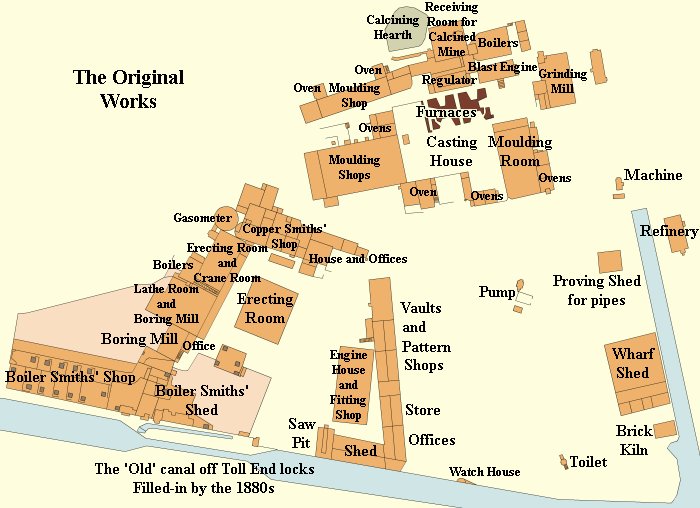
The original Iron Works and Factory. It stood
to the east of Upper Church Lane, north of Tipton Brook, south of
where Arthur Road is today. |
|
Thanks to Aaron Manby,
the engineering business quickly developed.
Some of the earliest products were marine
steam engines. On the 9th July, 1821, Manby
took out a patent for an oscillating marine
steam engine and for the use of oil to
get-up steam. He also took out a French
patent for the design and for an iron ship.
He formed a company in France with Charles
Napier to operate steam boats on the Seine
between Rouen and Paris. Their first iron
boat was built at Horseley and registered on
the 30th April, 1822 as ‘Manby’, although it
was generally known as the ‘Aaron Manby’.
After successful trials, the ship crossed
the channel and became the first iron ship
to put to sea. It successfully operated on
the Seine for about thirty years.
Aaron Manby left
Horseley and moved to Paris where he opened
a factory at Charenton. A second iron hull
was built at Horseley, and completed at
Charenton. Manby’s leaving had a bad effect
on the Horseley business, resulting in a
lack of orders. The problem was made worse
because Manby offered jobs in France to many
of the best men in the factory. The
colliers’ strike in 1822 also had a great
impact on the business, which shut-down for
a time.
| |
|
Read about Aaron Manby,
his paddle steamer and its
commemoration in 2022 |
 |
| |
|
After Manby’s
departure, the firm began to build
steam locomotives. In 1832, several engines
designed by Cornish engineer, Matthew Loam,
were built for the St. Helens & Runcorn Gap
Railway. The engines were unreliable and
Loam left. He was replaced by Isaac Dodds
who designed a locomotive for the Liverpool and
Manchester Railway in 1833. The engine
worked well in trials, but was derailed and
considerably damaged. The railway company
decided not to purchase the engine, but did
agree to pay damages. On the 2nd September, 1833,
the locomotive was offered to the Dublin &
Kingston Railway at a price of £700. The
offer was declined, but the railway company
sent an order for a locomotive called
‘Star’. After delivery in 1835 the pair of
small wheels was found to be unsound, so Horseley provided a replacement. After the
new wheels were fitted, the locomotive
derailed and was damaged.
Horseley supplied a
stationary engine to the Leicester &
Swannington Railway in 1833. It was designed
by Robert Stephenson. The engine was later
modified and continued in operation until
1948. It is now in the collection at the
National Railway Museum at York.
The firm is best known for its cast iron
bridges. One of the first was a swing bridge
built for the East India Docks in 1816. Many
of the firm’s bridges can be seen on the BCN
network, including the 'Old Turn' canal
bridge built in 1827, (now beside the Malt
House pub in Birmingham) and Galton Bridge
at Smethwick, built in 1829. At the time it
was the highest bridge in the world. Bridges
were also built for many canals including
the Oxford Canal, the Grand Union Canal, the
Birmingham and Fazeley Canal, and the Wyrley
and Essington Canal.
In the 1840s Horseley
Works ran into financial difficulties and in
about 1846 went into liquidation. The business was
put-up for sale and advertised on at least
three occasions in the Wolverhampton
Chronicle. The adverts include a detailed
description of the site and so are of great
interest. The site was eventually
purchased by three local ironmasters, J. J. Bramah, Deeley, and Cochrane,
who leased it to Broad and Tierney for 21
years in 1852.
|
| |
|
| Read a
description of the original factory from the
sale adverts in the Wolverhampton Chronicle |
 |
| |
|
|
The New Works
In 1864, Robert Broad
purchased two pieces of land on which to
build a new foundry. The old factory was
outdated and the blast furnaces were no
longer required. Lack of rail access to
the old site may also have been a factor.
The new factory buildings were designed by
William Dempsey of London and John Weller of
Wolverhampton. They were built by David
Murray.
There were pattern
shops; a foundry, boiler shops, fitting shops
and offices. All of the cast iron work for
the new buildings was cast in the old
factory.
Early orders included a
water tank, sent to Berlin and a gas holder,
sent to Vienna. Orders were also received from
Bombay, Argentine, Birmingham, Portsmouth,
Aberystwyth, Chester, Conway, Croydon,
Crystal Palace Gas Works, the London & North
Western Railway; and the London & South
Western Railway. Most of the orders were for
gas holders and gas plant.
|
|
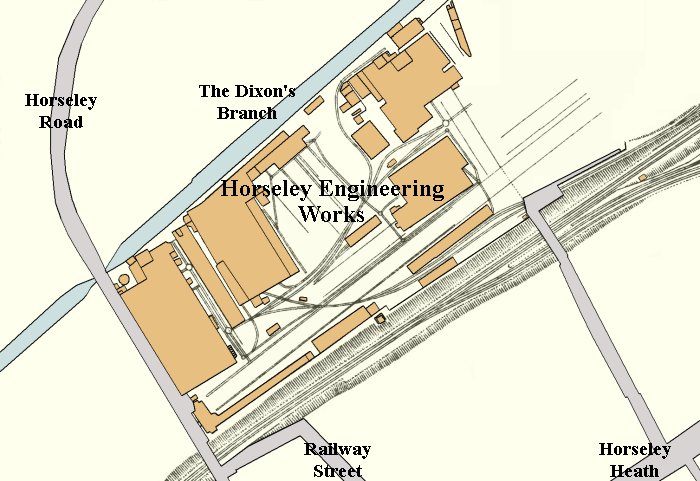
The location of the new factory, as it was in
1913. |
|
In January 1874 after
eight years as a private company, the
business went public under the name of The
Horseley Company Limited. The Chairman was
Tipton ironmaster, Robert Broad, with
Frederick Ernest Muntz, of Gloucester Terrace,
Hyde Park, as Joint Chairman and John
Cochrane, an ironmaster from Park Gate
London, as Vice Chairman. The other
Directors were: George Frederick Muntz, who
was also Chairman of the Birmingham Stock
Bank Limited; James Holcroft, a Stourbridge
iron and coalmaster; Joseph Scrivens Keep,
from Birmingham, who was also Director of the Midland
Wagon Company; and Thomas Short, based at London and
Birmingham, an East India merchant. John
Spencer remained as Secretary and George
Edward Jones remained as Works Manager.
On 2nd January, 1874,
Robert Broad died. He was replaced as
Chairman by John Cochrane. Thomas Short
became Vice Chairman. A new steam riveting
machine was installed in the boiler shop in
1876, and in 1877 John Cochrane resigned. He
was replaced by Peter Duckworth Bennett, a
West Bromwich ironfounder. The firm acquired
his business and decided to sell his loss-making Spon Lane Foundry in 1880. James Holcroft
resigned in April, 1877. Peter Duckworth
Bennett died on 28th November 1885 at the age of
60, in a lunchtime accident in Birmingham.
He went to a lunch at the Birmingham Council
House during the Prince of Wales’ visit to
the City. He climbed onto the portico to get
a better view of the proceedings and fell to
his death. He was replaced as Chairman by
Joseph Scrivens Keep.
In 1878 the company’s
products included ironwork for four gas
holders at Manchester, Ryde Pier on the Isle
of Wight, and a warehouse at Heaton Norris.
In 1879 ironwork was produced for Harwich
Pier, and in 1880 for a gas holder at
Poplar, for two gas holders for Tipton Gas, and
three bridges for the London & South Western
Railway Company. In 1882 iron work was
produced for a large jetty at Port
Elizabeth, South Africa, a bridge over the
River Itchen near Southampton, and a bridge
over the River Aire for the Hull, Barnsley &
West Riding Junction Railway.
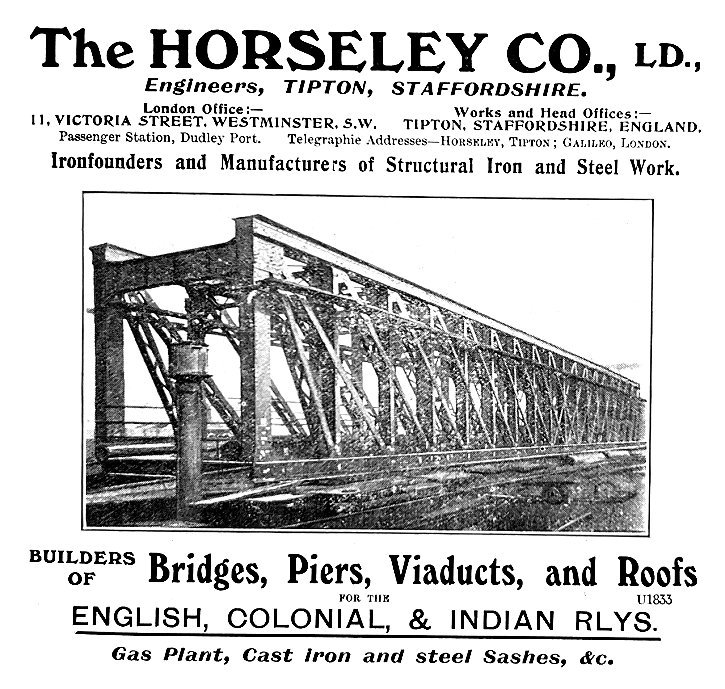
In 1883 orders included
ironwork for two gas holders for the Gas
Light & Coal Company, Westminster, one gas
holder for the Bilston Gas Light & Coal
Company, and a warehouse at Huddersfield for the
London & North Western Railway. In 1884,
ironwork was produced for the widening of
Charing Cross Bridge, London, and Medway
Bridge, Rochester. In the following year,
ironwork was produced for Rugby Railway
Station extension, Monument Lane Station,
Liverpool,
Brunswick Dock, also at Liverpool, and Birkenhead
Gas Works. Other orders for bridges in the
1880s included Osney Bridge over the River
Isis at Oxford, a swing bridge over the
River Dee, two jetties for Table Bay, Cape
of Good Hope, a pier for Port Elizabeth,
South Africa, and a bridge for Japan.
Working in an ironworks
could be a dangerous business. In October
1878 two men lost an arm when a girder
slipped, and two men were seriously injured
at the Ryde Pier site. In May 1879 a man was
killed in the works when a bar of iron fell
from a wagon, a man was also killed on the
Manchester Gas Works site, and another man was
killed at the Commercial Gas Works site at
Poplar, Tower Hamlets, London, followed by a
second fatality in 1881. Between 1877 and
1881 there were 23 accidents at the factory.
There were also fatal accidents at the
Liverpool Alexandra Dock Warehouse and
Dudley Gas Works.
In 1890 an order was
received from the Admiralty for 133
cylinders, with diameters of 7, 8, and 10
feet. Columns and guides for Montevideo Water
Works at Rio de Janeiro were also ordered,
along with ironwork for Beckton Gas Works, the Great Eastern
Railway, Daventry & Leamington Railway,
Colombo Harbour Jetty, and Liverpool Street
Station roof, in London. In 1892 the company
had a staff of 730, along with 171 outworkers. A new
planning machine was purchased for the
boiler shop in 1900 along with a 50hp. gas
engine. The company continued to purchase
extra land adjacent to the factory,
something that had been going on since the
1870s. The land had previously been used for
coal mining.
|
|
Much of the girder work
had always been done in the factory yard, in
an area known as the races. In 1904 two
large workshops, 150 feet long and 40 feet
wide were built so that the girder work
could now be carried out under cover. Joseph Scrivens Keep who had been Chairman since
1877, died on 13th April, 1907. He was
replaced by Frederick Ernest Muntz. In
February 1910 Rowland Hill, of The Firs,
Kidderminster became a Director. He remained
as such until January 1915 when he died.
Another Director, Charles Holcroft, died on
11th March, 1917 and was replaced by his
nephew, S. H. H. Henn.
In 1916 the firm became
The Horseley Bridge & Engineering Company
Limited, a name which was thought to be
more appropriate. During the First World War
the company produced mines, mine sinkers,
steel barriers for Scapa Flow, sheds, steel
buildings, buoys for the Channel barrage,
and booms and paravanes that were used by
ships to clear mines.
In 1919 J. W. Baillie became Secretary (he
would eventually become Managing Director).
The boiler shops were extended, new machines
and a new weighbridge were installed and
alterations were made to the offices. In
November, the following year, the Chairman,
Frederick Ernest Muntz died. He was replaced
by J. T. Daly in January, 1921.
In the early 1920s, a shortage of orders led
to a recession, which lasted for many years.
In 1925, orders included six bridges for the
Southern Railway, and in 1926 lift bridges
for Nechells Power Station and steelwork for
the LMS. The final profit for the year was
only £6,000 so no dividend was paid. The
General Strike in 1926 and the continuing
miners’ strike led to the closure of the
factory from May until the end of December.
During this time a lot of maintenance work
was carried out on the site.
The orders for 1927
included swing bridges for the Port of
London Authority, crane runways for Derby
Locomotive Works, a bridge for the Southern
Railway and a rolling lift for Tilbury
Docks. A rolling lift bridge was ordered for
the docks at Manchester Road, Millwall in
1928, along with a purifier for Stourbridge
Council and cast iron troughs for Bradford
Council.
J. T. Daly retired as
Chairman in June 1928 after 42 years on the
Board. The Horseley Company had decided to
amalgamate with Thomas Piggott & Company
Limited, Spring Hill, Birmingham, at a time
when both companies were short of work. The
amalgamation took place in June 1928 and
office staff from both companies were moved
to a new company office at 28 Lionel Street,
Birmingham. Sir Sydney Henn became Chairman
and the following new Directors were
appointed: T. P. Barker, A. Dyson, T. W.
Horton, Henry Bewlay, T. O. Lloyd, and J. W.
Baillie.
The foundry at Tipton
took over the work of Piggott’s foundry at
Spring Hill. The foundry foreman at Tipton
was dismissed and replaced with the foreman
from Piggott’s Foundry. Many orders arrived
for steelwork for the National Grid which
was being extended. This resulted in the
opening of a transmission tower steelwork
facility at Tipton. Orders were also
received for structural steelwork for
cinemas, which were becoming very popular at the
time. Other orders were for gas lamp columns
for Belfast and Liverpool, a landing stage
at Neyland, Wales, and Ammonia stills for
Belfast.
|
|
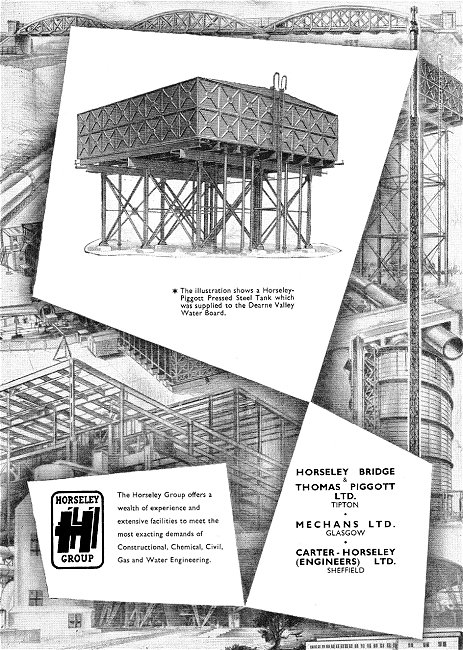
From 'Structural Steelwork'. |
In 1929 Sir George Holcroft resigned from the Board, and in
1931 the light construction shop was
extended.
In 1931 there were orders for the
Bute West Dock lock swing bridge at Cardiff,
a bridge for the LMS, and the reconstruction
of Meadow Hall, Sheffield, for the LNER.
The
recession continued; staff reductions were
made and there was a three day working week.
The situation became desperate. The only
orders in February 1932 were for electricity
transmission towers and so there were
further reductions in staff. The bank
refused to honour Piggott’s cheques and so
it was decided that an amalgamation of the sites
was essential. Piggotts went into voluntary
liquidation and the office staff were moved
from Birmingham to Horseley Works where the
office was redecorated.
In May 1933 an order
was received for the 900 feet high radio
mast at Droitwich and another for the repair
of Colwyn Bay pier. By the end of the
financial year the company had made a loss of
£530.
|
| On 1st January, 1934
the business became The Horseley Bridge &
Thomas Piggott Limited. It was decided that
a replacement factory for Piggott’s foundry
at Spring Hill should be built at Tipton, on
the site of the works’ sports ground on the
Great Bridge side of the railway line, where
there would be rail access. The factory was
known as Pipe Works. In 1934 Spring Hill
works were closed and work was well underway
at the new site. Spring Hill factory was
demolished in 1935 and Pipe Works was
completed and in full production by June
1936. |
|
In 1935 an order was
received for a swing bridge at Exeter and
trade began to increase. In 1936 an order
was received for a 2 million cubic foot
Klonne gas holder, from the Ford Motor
Company, along with an order for a one million
gallon water tank for a hydroelectric scheme
in Devon. By the end of the 1936 financial
year, a small profit had been made.

A letterhead from
1936.
On 13th October, 1936,
Sir Sydney Henn died after he broke his
thigh in a fall. On 11th March, 1937, the
Earl of Dudley was elected as a Director and
Chairman of the company. Orders in 1937
included 1,000 tons of steel for Imperial
Airways, London, steel for steel-framed
buildings for Cadburys, and 5,000 tons of
steel for aircraft hangars for the Air
Ministry. During the year, further
improvements were made at the factory
including a reorganisation of the girder
shop, and the building of new offices, which
had been completed by February 1939. While
building work was in progress, a temporary
drawing office was set up in a wooden
building in Horseley Road. This then became
the canteen.
In January 1938, T. W.
Horton, one of the Directors, died and
orders included a Scherzer lift bridge for
London County Council, and large amounts of
dovetail sheeting for air raid shelters. In
July 1938 a week’s paid holiday for all
employees was introduced, and air raid
shelters were built at the factory for the
employees. Business was improving, more
orders were received and a good profit had
been made by the end of the 1939 financial
year.
|
|
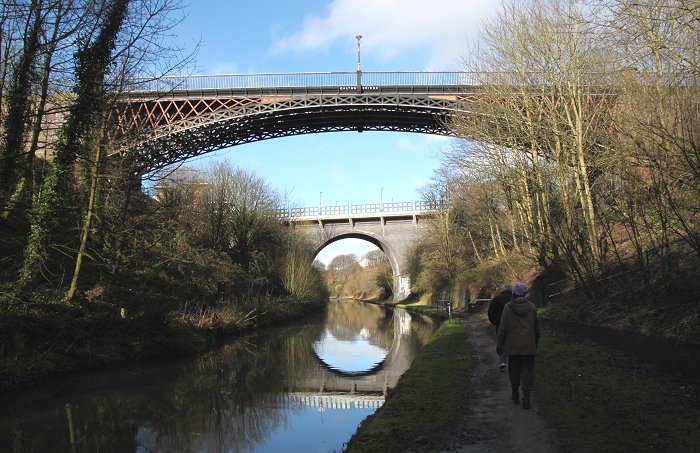
Galton Bridge, Smethwick, built in 1829. |
|
World War 2
At the beginning of the
war, the London office
closed and some of the staff were
transferred to Tipton, where the company
purchased Lansdowne House in Horseley Road,
for their occupation. 500 mines were produced each week
in the factory for the Admiralty, and new
machinery was installed for their
production. In July 1940 pipe contracts at
Pipe Works came to an end, because of the
war, so new contracts were sought in
order to keep the factory in operation.
The Horseley Platoon of
the Home Guard had 160 men who mounted
nightly fire watches at the works. The
company purchased 1,000 steel helmets for
them to wear during air raids. Enemy bombs
badly damaged gas holders at Coventry,
Smethwick, and Cardiff. The company received
orders for repairs to the damage. A new
dressing shop was built at the works and in
May 1941 the company was included in the
Ministry of Labour's Protected List under
essential work.
By October 1941, there
were 45 female factory workers on the site,
many of whom were trained as welders. New
toilets and cloakrooms were built for them.
In August 1941 an order was received for 300
small armoured plate bodies for ‘Beaverette’
tanks, and in November of that year an order
was received for 4,000lb. bombs.
On 14th April, 1942 the
Duke of Kent inspected parts of the factory
and on the 1st July, a new canteen was
officially opened by the Earl of Dudley. New
chemical and metallurgical laboratories were
built, complete with x-ray machines. In May
1942 the factory completed an order for six
stern ends for tank landing craft, more of
which were built in 1943. In December 1944
an order was received for 2,900 tons of
steel for the new Ocker Hill power station.
|
|
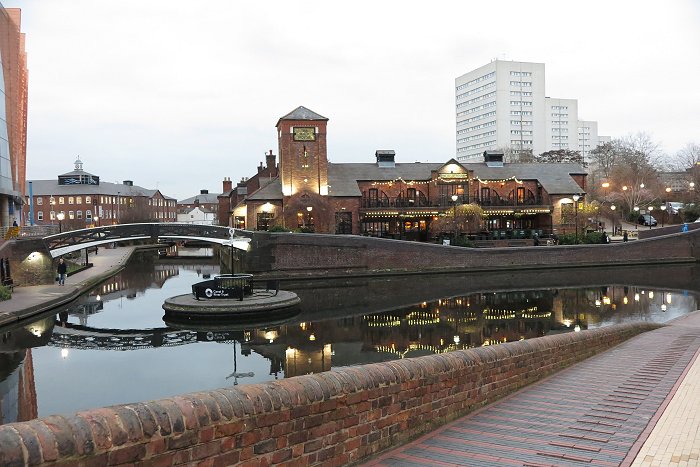
The 'Old Turn' Horseley canal bridge in
Birmingham. |
|
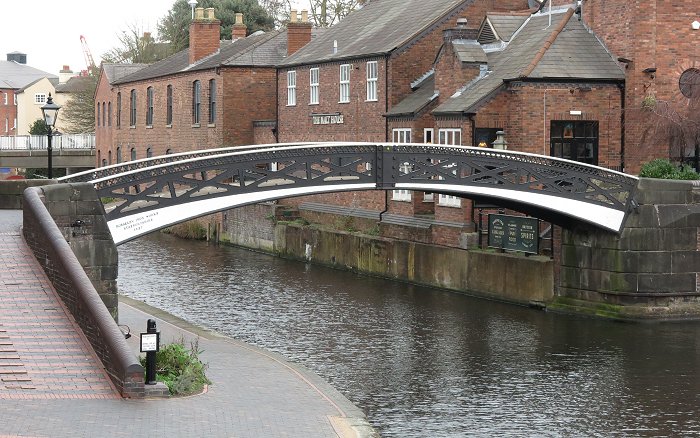
A close-up view of the bridge in the above
photo, built in 1827. |
|
The Post-War Years
In 1945 an order was
received for 700 tons of Calendar-Hamilton
bridge units for Dutch railways and in May
1946 an order was received for 7,000 tons of
steel for Walsall Power Station. Another
order was for a number of steel frames for
houses.
In January 1947 the 5
day working week was introduced, at which
time the factory was having problems due to
a shortage of steel. In February 1947,
Thompson Brothers of Bilston ordered a steel
portal framed building and in March an order
was received for two bridges at New Street
Station requiring 800 tons of steel. They
were the last bridges built at the works
using riveted construction.
|
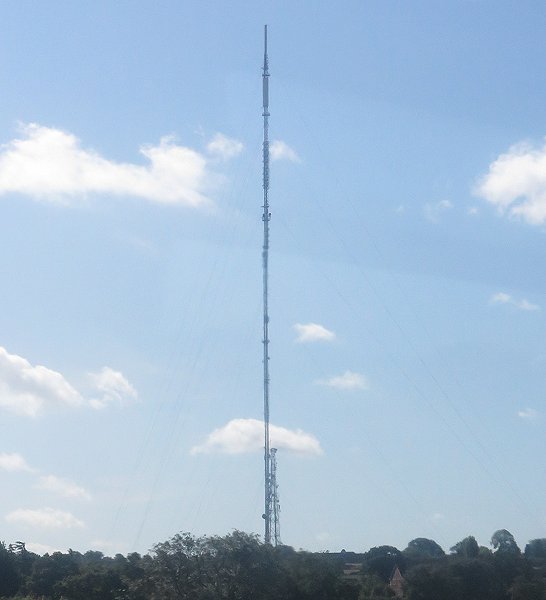
Sutton Coldfield television
mast. |
In June 1948, J. W. Baillie became Managing
Director and on 20th December, 1948, the
Earl of Dudley officially opened the new
foundry.
In April 1949 the company’s
largest built-up girder was made for the
Sutton Coldfield television mast. It was 785
feet high and weighed 80 tons.
The company
received an order for the base supports for
the ‘Dome of Discovery’ at the Festival of
Britain in November 1949. It required 232
tons on aluminium and 133 tons of steel. In
October 1949 the company took over George M.
Carter (Erectors) Limited and renamed the
company Carter-Horseley (Engineers) Limited. |
At the end of 1949 an order was received
from Port Talbot for a gas holder of one
million cubic feet, and in May 1950 J. S.
Christie became Company Secretary. The
company purchased a new sports ground from
Triplex Foundry Limited, in 1952, having
shared it with them for five years.
In 1953 the company
constructed Ince Power Station. At the end
of the year J. W. Baillie retired, but had a
short retirement. He died in July 1954. On
his retirement James Christie and Vincent
Senior became joint Managing Directors.
Orders received in 1954 included the
building of a portal bridge over the Walsall
canal and a fatigue testing tank for
aircraft built at Farnborough.
The company acquired
Mechans Limited, on the Clyde, in 1957. The
firm only survived for six years after
take-over because of the decline in Scottish
shipbuilding. The factory closed in 1963 and
some of the products including water-tight
doors for ships were transferred to Tipton.
The 100th Powermaster boiler was produced at
Tipton in 1957 for G.W.B. Limited of Dudley,
and during the year, Concrete and Structural
Products Limited was acquired as a
subsidiary of Carter-Horseley.
The first all-welded
high strength steel bridge was built at
Maidenhead over the River Thames in 1960,
along with the head and tail sluice gates
for the flood control scheme at Dover and
Kings Lynn. The company acquired G. H.
Whitehouse & Son Limited in 1961. Their
plant was moved to the Horseley factory to
become the company’s new machine shop.
During the year, orders were received for two
major power-line crossings, one over the
River Severn and another over the River
Thames.
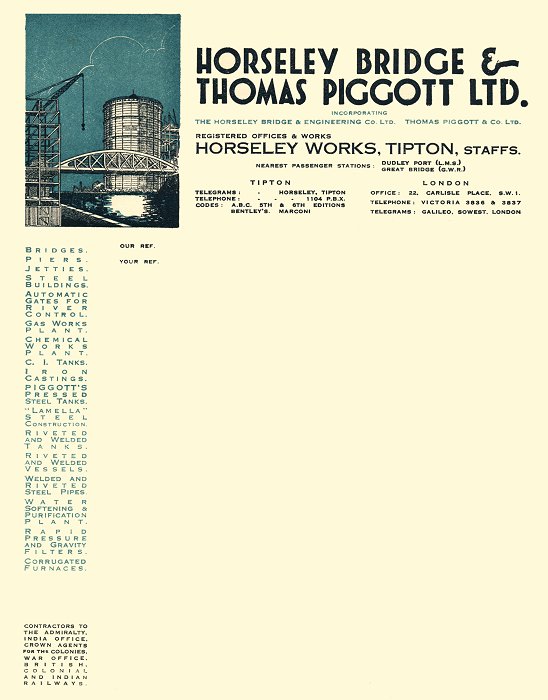
A letterhead from
1936.
In 1964 three radio
telescopes with a diameter of 60 feet where
built for Cambridge University, and a
significant investment in new plant was made
at Tipton, including a 2,000 ton press for
the hydraulic shop, an updating of ‘A’ bay
into a Class 1 welding shop, the building of
an x-ray shed, shielded with lead sheets, new
welding sets and a hydro test pump. The Dixons
Canal Branch was removed in order to
increase the tower storage area and a Merlin
gas cutting machine was purchased for the
Pipe Works. Investment continued in 1965
with the purchase of large lathes, radial
drills, a rail crane, 600 amp welding sets,
a large hole cutting machine and a new
layout for the hydraulic shop.
A large contract was
received in 1965 for work on Rugeley ‘B’
Power Station. The firm’s main products were
now pressure vessels, heat exchangers, and
process vessels in many materials, including
stainless steel. Some of the vessels and
heat exchangers had tubes with sides that
were twelve inches thick. Further investment
in 1966 included a Merlin gas cutting
machine for stainless steel, Wadkin tape
drills, argon arc and MIG welding sets,
grinding machines, and a plasma arc torch
for the Pipe Works. The welding shop became
the special products shop, a Unionmelt
vessel welding machine was acquired for ‘A’
bay and the old coke braziers in the factory
were replaced with gas heaters.
Two moving footbridges
were built for the Madras Port Trust and
work was completed on the replacement Marlow
Bridge, over the River Thames. Horseley-Piggott
(Coatings) Limited was set up to use a new
system of pipe coating and on the 29th March,
1966 a holding company, Horseley Bridge
Limited was set up. The last issue of the
firm’s magazine, Horseley Group News was
produced at Christmas, 1967 and a training
school opened at the Carter-Horseley
offices.
|
|

Another Horseley footbridge over the BCN in
Birmingham. |
|
The latter Years
In September 1968,
Horseley merged with the John Thompson
organisation at Ettingshall, Wolverhampton.
The organisation agreed to acquire the whole
of the issued capital of Horseley Bridge
Limited. Many orders were received at that
time, including one for Class
1 pressure vessels and another for the
reconstruction of Marlow and Hammersmith
suspension bridges. Other orders were for complex pipe work for a
wind tunnel at RAF Bedford, the pipe bridge
and road crossing over the River Severn at
Hampton Loade and a high level box girder
bridge at Milford Haven.
The pipe industry began
to decline due to lack of investment because
of the proposals for nationalisation. As a
result the Pipe Works closed and the site
was sold. Horseley then concentrated on
structures, cranes and bridges, but times
were difficult due to a shrinking market.
The light construction shop was demolished,
but attempts to sell the land failed. The
land across the road, where the canteen and
garage stood was sold.
Because of the
deepening industrial depression in the
country, the order books contained many
loss-making contracts. At the time, the
industry as a whole, had been quoting ever-low prices
which resulted in the closure of 190
fabrication companies in the 15 months prior
to April 1992. The Horseley factory was
put-up for sale and demolition contractors
were appointed, while the factory was still
in operation. The business formally closed
on the 15th May, 1992 with a loss of 350
jobs, which must have been heartbreaking for
many of the ex-employees, because jobs were
in short supply due to the industrial
depression. This was a sad end and a bitter
blow to a company that had achieved so much
during a lifetime of 200 years.
|
 |
Return to
the
previous page |
|